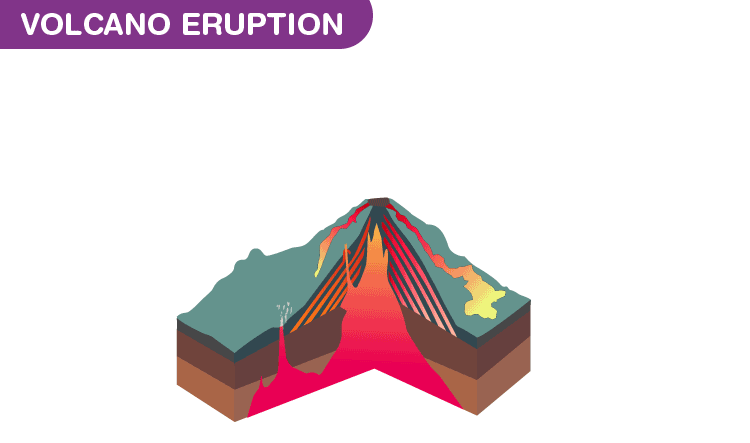
Volcanoes are ruptures in the crust of our planet Earth that allow hot gases, molten lava and some rock fragments to erupt by opening and exposing the magma inside. In this piece of article, we will be discussing how and why volcanoes erupt.
| Table of Contents: |
How Do Volcanoes Erupt?
It is so hot deep within the earth that some rocks slowly melt and turn into a thick flowing matter known as magma. Since it is lighter than solid rock, the magma rises and collects in magma chambers. Eventually, some magma pushes through fissures and vents on the earth’s surface. Hence, a volcanic eruption occurs, and the erupted magma is known as lava.
We need to understand the Earth’s structure to know how volcanoes erupt. At the top lies the lithosphere, the outermost layer that consists of the upper crust and mantle. The thickness of the crust ranges from 10km to 100km in mountainous locations and mainly consists of silicate rock.
See the video below to know more about the causes of volcanic eruptions.

Why Do Volcanoes Erupt?
The Earth’s mantle within the crust is classified into different sections depending on individual seismology. These include the upper mantle, which ranges between 8 – 35 km to 410 km; the transition zone ranges from 400 to 660 km; the lower mantle lies between 660 – 2891 km.
The conditions change dramatically from the crust to the mantle location. The pressures rise drastically and temperatures rise up to 1000 oC. This viscous and molten rock gets collected into large chambers within the Earth’s crust.
Since magma is lighter than surrounding rock, it floats up towards the surface and seeks out cracks and weakness in the mantle. It finally explodes from the peak point of a volcano after reaching the surface. When it is under the surface, the melted rock is known as magma and erupts as ash when comes up.
Rocks, lava and ash are built across the volcanic vent with every eruption. The nature of the eruption mainly depends on the viscosity of the magma. The lava travels far and generates broad shield volcanoes when it flows easily. When it is too thick, it makes a familiar cone volcano shape. If the lava is extremely thick, it can build up in the volcano and explode, known as lava domes.
|
Similar Reading |
Causes of Volcanic Eruption
We know that the mantle of the Earth is too hot, and the temperature ranges from 1000° Celsius to 3000° Celsius. The rocks present inside melt due to high pressure and temperature. The melted substance is light in weight. This thin lava comes up to the crust since it can float easily. Since the density of the magma between the area of its creation and the crust is less than the enclosed rocks, the magma gets to the surface and bursts.
The magma is composed of andesitic and rhyolitic components along with water, sulfur dioxide, and carbon dioxide in dissolved form. By forming bubbles, excess water is broken up with magma. When the magma comes closer to the surface, the level of water decreases and the gas/magma rises in the channel. When the volume of the bubbles formed is about 75%, the magma breaks into pyroclasts and bursts out.
The three main causes of volcanic eruptions are:
The buoyancy of the magma
Pressure from the exsolved gases in the magma
Increase in pressure on the chamber lid
Hope you are familiar with why volcanoes erupt and the cause of the volcanic eruption. Stay tuned to BYJU’S to learn about types of volcanoes, igneous rocks, and much more.
Frequently Asked Questions – FAQs
What is lava?
When a volcanic eruption occurs, the erupted magma is known as lava.
State true or false: The nature of the eruption mainly depends on the viscosity of the magma.
True.
What are the causes of volcanic eruption?
The causes of the volcanic eruption are:
Define magma.
How is Earth’s mantle classified?
- The upper mantle – ranges between 8 – 35 km to 410 km
- Transition zone ranges from 400 to 660 km
- Lower mantle lies between 660 – 2891 km

Comments